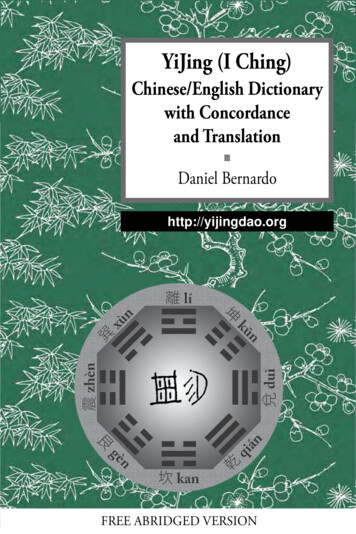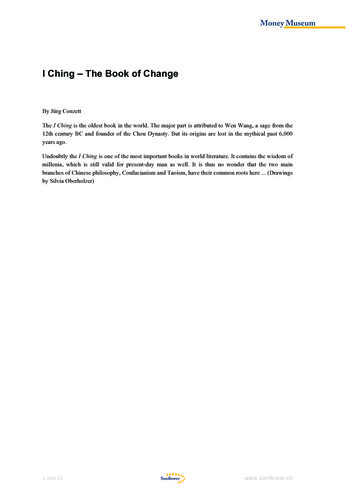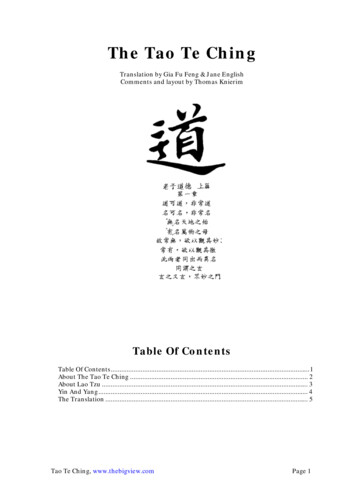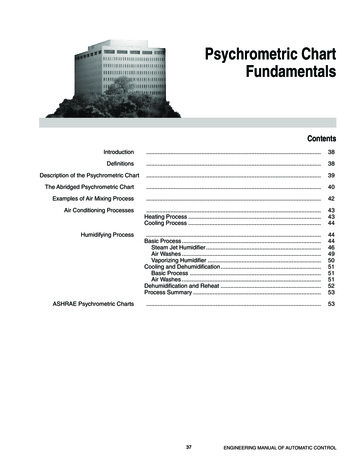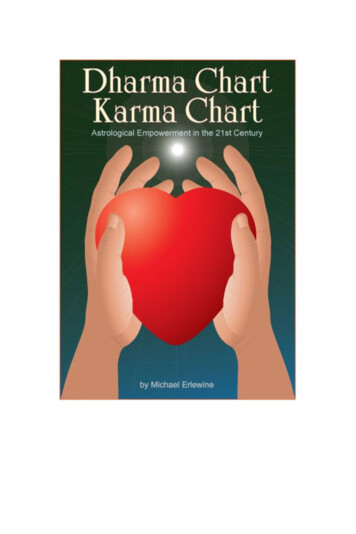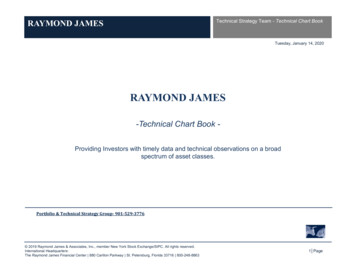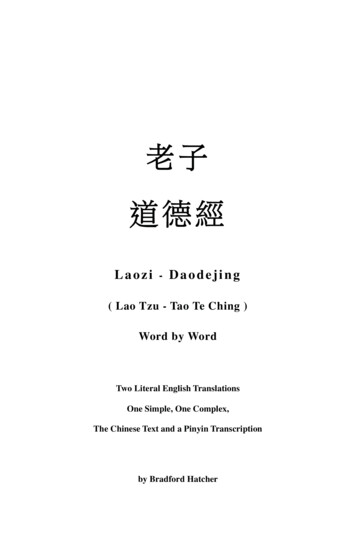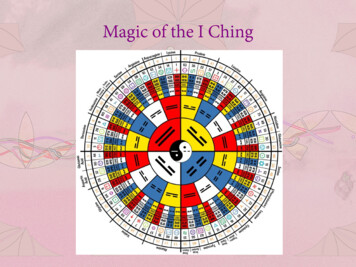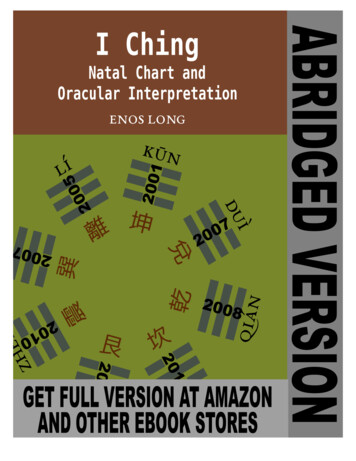
Transcription
I ChingNatal Chart and Oracular Interpretation 2018 by Enos LongAll rights reserved under International andPan-American Copyright Conventions.First Edition: July 2018https://sojournerbooks.com/
ContentsFront CoverCopyrightIntroductionHow to consult the OracleHow to get the Natal HexagramThe Yarrow-Stalks OracleUnderstanding hexagram readingsThe Eight TrigramsChart of Trigrams and HexagramsThe 64 hexagrams01 The Creative02 The Receptive03 Initial Difficulty04 Youthful Folly05 Waiting06 Conflict07 The Army08 Union09 Little Domestication10 Treading11 Harmony12 Standstill13 Fellowship14 Great Possession15 Modesty16 Enthusiasm17 Following18 Correcting Decay19 Approach20 Contemplation
21 Biting Through22 Elegance23 Splitting Apart24 Return25 Innocence26 Great Accumulation27 Nourishment28 Great Excess29 Pit Doubled30 The Clinging31 Influence32 Duration33 Retreat34 Great Power35 Progress36 Suppressed Light37 The Family38 Antagonism39 Hampered40 Liberation41 Decrease42 Increase43 Breakthrough44 Close Encounter45 Gathering Together46 Ascending47 Oppression48 The Well49 Revolution50 The Cauldron51 Shock52 Restraint53 Gradual Development54 The Marrying Maiden55 Fullness56 Sojourner57 Gentle Influence58 Joyousness
59 Dispersion60 Limitation61 Inner Truth62 Excess of the Small63 Already Across64 Before Crossing
IntroductionThe Yijing or Book of Changes (previously spelled as I Ching) was intended as a strategic oracle forfeudal lords in the Chinese Bronze Age, three thousand years ago, but with the pass of the centuries thebook was evolving and become more philosophical, under the influence of Confucianism.The Book of Changes is both an oracular medium and a book of wisdom, but it doesn’t try to answerwhy we are here or where are we going after death; instead it focuses in the business of living. It is alsoa human attempt to throw light in the natural laws that command change.Change is the natural state of this world. All things live in continuous flow. All beings are born, grow,evolve and finally decay and die. By observing the natural cycles, the sages of ancient times achieved anintuitive understanding of the laws that regulate change. Change is not chaotic, but it follows a pattern ofdevelopment. Change is inevitable; situations never are completely static and unchangingThe 64 hexagrams (or sections) of the Yijing are a description of the different ways in which situationscan evolve, they describe the steps of change and tell us how to act effectively at every moment.Since change happens through time, each hexagram describes different times. There are times foradvancing, times for retreating, times for peace, times for war, and so on. Each hexagram depicts adifferent time, a different pattern of change. This idea has echoes in the Bible (Ecclesiastes 3:1-8):For everything there is a season, and a time for every purpose under heaven: a time to beborn, and a time to die; a time to plant, and a time to pluck up that which is planted; a time tokill, and a time to heal; a time to break down, and a time to build up; a time to weep, and atime to laugh; a time to mourn, and a time to dance; a time to cast away stones, and a time togather stones together; a time to embrace, and a time to refrain from embracing; a time toseek, and a time to lose; a time to keep, and a time to cast away; a time to tear, and a time tosew; a time to keep silence, and a time to speak; a time to love, and a time to hate; a time forwar, and a time for peace.Knowing which kind of time we are experiencing allows us to take both preventive measures and to planthe best course of action in advance. In that way we can take the best course between the rough waves oflife. Sometimes we may have a smooth sailing, and ride along with the tides with little effort, but inother cases we will have to work hard to manage well the situation.Content and StructureThe Yijing describes change as a permanent cycle between two principles, one active and energetic andthe other passive and yielding. Those two principles are the building blocks of the 64 hexagrams of theBook of Changes, they are called yang and yin. The next table shows how yang and yin look whendrawn as hexagram’s lines.
FigureDescriptionAttributesYin lineFeminine, passive, dark,cold, soft.Masculine, active, light,hot, hard.Yang lineYin and yang are relative and changing attributes that interact constantly. Firm and dominant behaviorsare yang, weak and subordinate are yin. Yang and yin flow constantly, yang mutates into yin and viceversa. The flow of yang and yin is evident in the adaptation to the needs of each moment; somesituations require yang boldness, and other yin tolerance.All hexagrams are drawings composed by six yang and yin lines (except the hexagrams 1 and 2, whichare pure yang and pure yin).The yang and yin lines form a binary system; by combining both types of lines in six different positions,64 different hexagrams are created, forming the structure of the Yijing. All hexagrams are interconnectedbetween them; when the oracle answers a question it is usual to receive a pair of hexagrams, whichdescribes the flow of the situation.Each line in an hexagram describes a step in a situation. The lines are counted from bottom to top, beingthe bottom line the first one. The Yijing hexagrams describe how a situation develops in time, startingwith the first line and how it evolves until reaching its sixth line.Each one of the 64 hexagrams has some texts attached to its drawing: The hexagram title, known as “hexagram tag”, which is composed of the first one or two Chinesecharacters that form the Judgment. The Judgment (guaci), that describes the characteristics of the situation and its prognosis, either goodor bad. The Image (daxiang), which analyzes the relation of the trigrams that comprise the hexagram andsuggests the best course of action based on the symbolic value of them –you will learn more about thetrigrams later–. Also there are six other texts (yaoci), one for each line, which describe the opportunities and dangersof each step.Notice that this book always shows the original Yijing text as indentedlines, our own commentaries to the Yijing are show below the indentedlines for each text (Judgment, Image and Lines).Example (from the hexagram 45):
Fourth NineGreat good fortune.No defect.Here comes our commentary.All the text following the two lines above is our commentary. "Greatgood fortune. No defect" is the original text.Reality and discourseThe authors of the Yijing had different values from our contemporary society. They lived in a highlyhierarchical, patriarchal and feudal society.Because of this, some ideas or terminology used in this translation may be offensive or strange to acontemporary sensibility. In my comments on the Yijing original text, I try to show the original ideasfrom a modern point of view. I have used gender-neutral words as much as the English language allowsme, without damaging the style of the text. Nevertheless, I have been as faithful to the original book textas I can, because my intention is to offer a reliable translation; otherwise my book would be a differentbook, and could not be called I Ching or Yijing.The fundamental principles of life have not changed since the Book of Changes was written, we are nobetter or worse than our remote predecessors. The profound perceptions about human relations that theYijing offers us are still valid and can be applied to our lives in the same way they were in ancient China.Today as yesterday, fate is determined by both factors outside our reach and by our own capacity. TheYijing can help us to understand better the relation between external reality and our will, and becausethat it is an invaluable tool that will enhance the quality of our lives if we hear its message.Natal (birth) HexagramThe Yijing is a book about the philosophy of time. Each hexagram has its own time, but in this context,time is not only a number of minutes and hours, but has its own characteristics, its own color and flavor.The 64 hexagrams of the Yijing describe the different times that human beings can experience.Hexagrams are intertwined across its changing lines –if you don't know what changing lines are, youwill learn that in the following sections–, each hexagram has 64 different combinations of changinglines, so the Yijing describes 4096 (64 * 64 4096) different times.The hexagram that describes the time of our birth is our Natal Hexagram. That hexagram –orhexagrams, if you got changing lines– describes the tendencies that will develop throughout our live, ourcharacter, which is what will define our destiny.Our Natal Hexagram reveals our personal characteristics, indicates which lines of development are
optimal and which we should avoid and our possibilities in different fields.The Natal Hexagram can be read as a kind of navigational chart of life, knowing our real possibilities wecan take better advantage of our potential and avoid straying into dead ends.Before getting your Natal Hexagram, it would be good to read the next section, How to consult theoracle, to understand the basic principles of a Yijing reading.Of course, in many cases a person may want to ask specific questions to the oracle. Besides getting theNatal Hexagram, the oracle can be consulted with three coins (go to the next page for instructions) orusing the yarrow sticks method.The Name of the BookI used I Ching as title, because it's the title most people know. Here, inside this book I prefer to callit Yijing, because that is the accepted way of writing the pronunciation of the original Chinese nametoday, using the pinyin system. Note that I Ching and Yijing are simply two different ways of writing thepronunciation of the Chinese name in Western letters.The name of the Book of Changes, written in traditional Chinese characters is:
How to consult the OracleIt has been said that the answer is always hidden inside the question, meaning that you can only get theright answer if you know how to express your question clearly or if you know the right question.The Yijing will not answer your questions unequivocally but instead it will tell you a moral history,sometimes including several protagonists and possible outcomes. It is your task to put yourself inside thehistory, to understand which part is yours and which is the relation between answer and question.The oracle will chart for you the possibilities and dangers lurking ahead; if you open your intuition youwill understand the message. Perhaps the answer will not be clear at first, but if you keep meditatingover it, at some point you will grasp it.The questions should be clear cut, avoiding asking about several possibilities at once. If you want toknow which option is best, you should ask about one option first and then ask again about the otherchoice in a second consult; never include several alternatives in the same question. Think carefully whatyou want to ask, take your time; do not ask the oracle in a hurry or in a disturbed emotional state.Examples:Should I buy the car that John sells? This question is concise and will simplify understandingof the answer.Should I go to Paris or Londres for my next holiday? This sort of question will prevent youfrom getting a clear answer.Also you could simply ask the oracle to describe the situation, optionally giving a time frame.Example:What are my chances for getting a new job in the next six months?Always write down your question before beginning your consult, afterwards you may write the answerin the same paper sheet.Notice that the oracle may mirror your fears and expectancies in its answer, casting light over yourhopes and fears.In all cases the answer is mainly about you and your interaction with the world around you. The oraclecannot change an objective situation, but can help you to make the most within your circumstances,indicating both your shortcomings and strong points.Sometimes you will apprehend intuitively the meaning of the answer at once, other times you may haveto ponder about it for several days until at least you find what the answer means for you.
Getting your Yijing readingThe consultation process will generate six numbers, and you will draw a hexagram according to them.Most people use the coin-tossing method to get the numbers, but we also describe the ancient yarrowstalk method in The Yarrow-Stalks Oracle .Some people like to follow a predefined ritual before divination; if you are inclined to do so, the ritualmay help you to put your mind at ease.Indeed focusing your mind is what matters most, if you concentration wanders during the consultation itmay affect the final outcome. In an ideal world you should not consult the Yijing if you are not relaxedand without distractions, an altered state of mind doesn’t improve the practice of divination.Using the coins to get an oracular readingIt is said that this method has been in use since the fourth century BC, the yarrow-stalks method is older,but because the coin-tossing method is faster and easier it is more widely used at the present time.Traditionally three Chinese coins are used, but you can use any kind of coins, provided that all them areequal.
The coins should be tossed six times on a flat surface to get the six lines of a hexagram. You will drawthe hexagram from bottom to top, according to how the coins fall, as the following table shows:CoinsNumbersResultsThree tails2 2 2 6A changing yin lineThree heads3 3 3 9A changingyang line2 tails and1 head2 heads and1 tail2 2 3 7A static yang line3 3 2 8A static yin lineAs you can see tails are worth 2 and heads 3; when you add the numbers for the three coins you will get6, 7, 8 or 9 for each coin toss.Broken lines are yin and whole lines are yang. If there are one or more changing lines, they will generatea second hexagram, with all changing lines inverted: yin will become yang and vice versa.After you toss the coins six times you will have a six lines drawing which depicts the oracle answer.
Example (the first column shows the line number and coin toss value for that line):Hex. 55Hex. 21L6: 6L5: 8L4: 7L3: 9L2: 8L1: 7As you can see, the changing lines are drawn differently from the non-changing lines, adding an X or acircle in the middle.In the previous example, the hexagram on the left (55) is the first one that you will draw. In thisexample, it has two changing lines: a yang line in the third position and a yin line in the sixth position.The second hexagram (21) is similar to the first, but the two changing lines are replaced with theiropposite ones. If the changing line is yang, replace it with a yin line and vice versa.If there are no changing lines, you will get a single hexagram.After drawing the hexagram/s see the Chart of the Trigrams and Hexagrams , to get the number/s of the hexagram/s.Returning to the previous example, where we got the hexagram 55 that mutates to the 21; we must readthe Judgment, the Image and the third and sixth lines of the hexagram 55, but only the Judgment and theImage of the hexagram 21.The hexagram 55 is the starting point of a situation that will lead to hexagram 21, which describes thefinal situation. Note that both hexagrams can be linked in other ways, seeUnderstanding hexagram readings to learn how to interpret hexagram readings better.What are changing linesWe get a changing line when a coin toss has three tails or three heads –6 or 9 value–. The changing linesgenerate a second hexagram; if there are no changing lines, we get a single hexagram, which depicts aslowly evolving situation.Changing lines are the steps of change that are activated in the hexagram reading; because that we willexperience only the situations described by the changing lines we got.Changing lines are also the lines more charged with energy. Yang and yin always change, yang mutates
into yin and vice-versa. When the yang or yin lines are strongly charged with energy, they flip, mutatinginto its opposite, that is the reason changing lines generate a second hexagram.
How to get the Natal HexagramThe hexagram that corresponds to the date and time of birth is the Natal Hexagram and it is theequivalent to what the astrologers call Natal Chart or Birth Chart. That hexagram describes the trendsthat will develop throughout life and the development of character, which is what defines destiny.The Natal Hexagram reveals the main characteristics of the person, indicates the opportunities anddangers that may arise; it also shows the possibilities in different fields of life, like work, socialrelationships, travel, etc.The Natal Hexagram can be read as a kind of navigational chart of life, useful to take better advantage ofour potentialities and avoid deviating from the right path by taking dead ends.
Steps to get the natal hexagramThe Natal Hexagram is obtained from the date and local time of birth. The exact time is not mandatory,but by knowing the time, it is possible to get a much clearer description of a person's life chances.As we explained previously, each hexagram is formed by two trigrams, one corresponds to the threeupper lines and the other to the three lower lines.
The steps to get the Natal Hexagram are:1.2.3.4.Get the upper trigram, corresponding to the year of birth.Get the lower trigram, corresponding to the month and day of birth.Get the changing lines, which depend on the local time of birth.Taking the two trigrams and the changing lines, we can see which hexagram we have.Get the natal hexagramA practical exampleFor a person born on September 4, 1992, at 18:20 hs.First we will get the upper trigram, as the century of the birth is even (XX), we will go to the table of theupper trigrams for the even centuries (click Get the natal hexagram to see the tables). That tableindicates that the upper trigram for the year 1992 is.Now we will seek the lower trigram, going to the table of lower trigrams for each period of the year, wewill find that the lower trigram for the period 08/17 - 09/30 (August 17 to September 30) is.Finally, since we know the time of birth, we can see which changing lines the natal hexagram has.Going to the table of changing lines for even days we will see that for someone born between 18:00 and18:44, the lines that mutate are 4 and 5.Knowing the two trigrams for the Natal Hexagram, we should see which hexagram they form, at theChart of Trigrams and Hexagrams .
Now we can now draw the Natal Hexagram with its changing lines. The following table shows the resultof your example.The first column shows the line number. Remember that the changing lines are marked with an X orwith a circle, for that reason we marked the upper trigram with two circles on the yang lines in positions4 and 5; because those two lines changed.The second hexagram (22) is similar to the first, but the two changing lines are replaced with itsopposite ones. If the changing line is yang, replace it with a yin line and vice versa.#Hex. 13Hex. 22654321As you can see, we got the hexagram 13, Fellowship ; when it mutates, originates a second hexagram,the 22, Elegance .Fellowship indicates that you are very linked to the community that surrounds you.Elegance means that it is very important for you to behave with delicacy and cordiality, with discretionand elegance.Now we should look at the two lines that mutate in Fellowship, which are:Fourth line: Tendency to isolate oneself from others due to distrust. It can be a recurring theme, you willalways have to overcome your initial mistrust before you can trust your neighbor. The good thing aboutthis provision is that you will not take undue risks, the bad thing is that you can lose some opportunitiesdue to your prejudices.Fifth line: Conflict and mistrust keeps people apart and causes unnecessary suffering. If you take thefirst step and show your sincere commitment, the union will be restored and everyone will be happyagain.This is only a basic idea of the meanings of all parts of this Natal Hexagram (the Judgment and Image ofboth hexagrams, and the changing lines of the first hexagram):You are very careful with your image (22) and position in the social group to which you belong(13). Despite your natural elegance and cordiality, you are very cautious and suspicious (4thline). You will be someone very difficult to cheat, although your prejudices can hinder your
relationships (5th line). Your membership in the social group is very important and you willalways keep in mind the proper conduct for each situation (the Image, Hex 13).There seems to be a repetitive situation of approaching and distancing from others; youapproach others because you need them and because you miss the fellowship after having left,but also you have a hard time withstanding the foolishness and imperfections of others.You are well suited for working with other people because you know how to behave in public,and how to communicate with groups, but you also know how to draw the line when othersmisbehave. You also know how to project the proper image and will be an example for others.Learn how to relax, sometimes you get too stressed out.Possible fields or work: Diplomacy, public relations, sales, manager, artist.The Natal Hexagram also allows us to analyze both the internal and external sides of a person, bystudying the characteristics of the the two constituents trigrams of the first hexagram obtained. Weshould user the upper and lower trigrams that we got from the tables related with the years and periodsof the year.The upper trigram shows the person's performance in the world, his/her social personality and how isseen by others.The lower trigram describes the inner, hidden and subjective part of the person, his/her feelings,aspirations, dreams and fears.We can see the descriptions of each trigram at The Eight Trigrams . There we can see all thecharacteristics associated with each trigram, its strengths, defects, sympathies, etc.
The Yarrow-Stalks OracleThe yarrow stalks oracle method has been in use for the last three thousand years as the traditional wayto consult the Yijing.The stalks used by the ancient Chinese were dried stalks of the Asian Yarrow, Achilea mongolica, inEurope the closest species is the European Yarrow, Achilea millefolium. Notice that some people usethin wooden or bamboo sticks instead Achilea stalks.The number of sticks is fifty. We do not know the size of the sticks in ancient times, but any thickness,length and material will suffice, if you can handle them easily in your hands.If the number of sticks is not fifty, they will not produce the correct results; hence they should be storedsafely to avoid losing any stick. It is advisable to keep the sticks wrapped in a clean linen cloth or atleast store them in a container that keeps them clean.Notice that the probabilities of get changing yang and yin lines are not the same using the sticks thanwhen using coins to get an oracle.With coins, there is the same chance of obtaining changing yang or yin lines, but with the sticks, thereare more chances of obtaining changing yang lines than changing yin lines. When tossing coins there is aone in eight chance of obtaining a changing line –either yang or yin–, when using sticks there is one insixteen chance of getting a changing yin line, but three in sixteen chances of getting a changing yangline. The probabilities of getting non changing yang and yin lines are evened with coins, but with sticksthere is slightly more chance of getting non changing yin than non changing yang lines.In practice, both oracular methods work equally well. The main difference is that coin tossing is easierand faster but using the sticks is more complicated –at least until you are used to it– and takes moretime. You can see how to get the oracle with coins at How to consult the Oracle .
UsageAfter you have written your question, unwrap the 50 sticks and put one of them back in the linen clothwrap, since only 49 will be used. Follow the steps below six times to obtain the six lines that will drawthe hexagram –there may be two hexagrams if there are changing lines in your answer– that will be theoracle’s answer. Lines will be drawn from bottom to top.1. Divide the 49 sticks at random in two heaps and put them on the table, on your right and leftsides.2. Take one stick from the right-hand heap and place it between the little and the ring fingers ofyour left hand.3. Take the left-hand heap with your left hand and start taking groups of four sticks from it,placing them away (in a heap that we will call Group A), until you have 4 or less sticksremaining in your left hand. Place this remainder between the ring and the middle fingers ofyour left hand.4. Take the right-hand heap with your left hand and start taking groups of four sticks from it,placing them away (in Group A), until you have 4 or less sticks remaining in your left hand.Place this remainder between the forefinger and the middle finger of your left hand.5. Now you will have either 9 or 5 sticks in your left hand: the first one that you put there beforecounting groups of four, and the two remainders of the counting. If there are 9, count 2; if thereare 5, count 3; write down that number. Notice that you will have to write down three numbersfor each line of the hexagram.6. Put away the sticks in your left hand (in a heap that we will call Group B), leaving only thesingle stick between your little and ring fingers. Divide the sticks in Group A in two heaps atrandom and put them on your right and left sides. Go back to step 3 and repeat the previoussteps until you have written down three numbers (3 3 3, 2 2 2 or different combinations of 2and 3).7. Once you have written down three numbers you already have defined one line of the hexagram.Join all the 49 sticks on the table (Groups A and B) and go back to step 1. After you have thenumbers for the six lines, the divination will be concluded. Write the three numbers for eachline in a separate line, starting from bottom –for the first line–, to top –for the last line–.
After you consultation is done you will have written down some numbers (always from bottom to top)as the following example shows:6th line 2 3 3 8 A static yin line5th line 2 3 2 7 A static yang line4th line 3 2 2 7 A static yang line3rd line 3 3 3 9 A changing yang line2nd line 3 2 3 8 A static yin line1st line 2 2 2 6 A changing yin lineAs you can notice each number corresponds to some kind of line.Broken lines are yin and whole lines are yang. If you have any changing lines in your hexagram, asecond hexagram will be generated by replacing every changing line by a non-changing line. If thechanging line was yang it will be replaced by a yin line and vice versa.
The first hexagram shown in the above image (31), will change or mutate to the second one (17), as youcan see in the following table:3117The first hexagram (31) has two changing lines. To get the second hexagram, copy the first one, butreplacing changing yang lines by yin lines and changing yin lines by yang lines. In this example only thefirst and third lines change.Of course, if there are no changing lines you will not have a second hexagram.For information about the interpretation of the answer see Understanding hexagram readings . Toknow the hexagram numbers for your own Yijing readings, please seeChart of the Trigrams and Hexagrams .What are changing linesWe get changing lines when a line has a 6 or 9 value. The changing lines generate a second hexagram; ifthere are no changing lines, we get a single hexagram, which depicts a slowly evolving situation.Changing lines are the steps of change that are activated in the hexagram reading; because that we willexperience only the situations described by the changing lines we got.Changing lines are also the lines more charged with energy. Yang and yin always change, yang mutatesinto yin and vice-versa. When the yang or yin lines are strongly charged with energy, they flip, mutatinginto its opposite, that is the reason changing lines generate a second hexagram.
Understanding hexagram readingsThe interpretation of oracular responses is more of an art than a science, use the guidelines outlinedbelow as useful tools to structure and analyze the answer got from the oracle, rather than absolute rules.General guidelinesAlthough basically you would only need to read the changing lines, Judgment and Image, if you are notfamiliar with the Book of Changes, it would be good to read the entire hexagram, because that way youwill get a clearer idea of the time you will have to live through.After reading the full text of the hexagrams (it can be one or two, if there are changing lines),concentrate on the specific parts referring to the reading you got; first read the Judgment and the Imageof the first hexagram, if there are changing lines, read them –only in the first hexagram– and then readthe Judgment and the Image of the second hexagram.If you got only one hexagram, the situation will not change very quickly and you should only read theJudgment and the Image to know how the circumstances will develop and what kind of behaviour ismost appropriate.If you got two hexagrams, the first hexagram describes the immediate situation and the second its futuredevelopment, although both may be linked in other ways, see How to interpret the second hexagram,further down in this same section.Sometimes the oracle will be easily understood as you read it, you will be able to see clearly how theanswer you get applies to your life.Other times, the answer may seem like a coded message, which has little to do with the reality thatsurrounds you; in that case, keep the oracular response in your mind, as a pending matter; meditate on it,don't dismiss it. Let some time go by, maybe you could reread the answer the next day. If you persist, atthe some moment, you will be able to see clearly how the hexagram reading applies to your life.How to interpret t
Introduction TheYijingorBook of Changes(previously spelled asI Ching) was intended as a strategic oracle for feudal lords in the Chinese Bronze Age, three thousand years ago, but with the pass of the centuries the book was evolving and become
